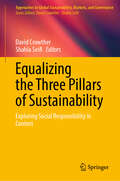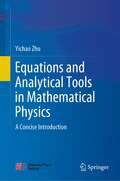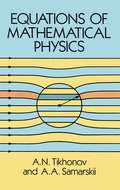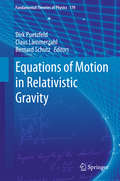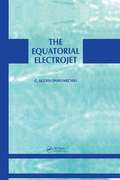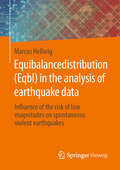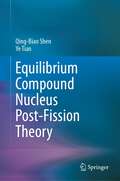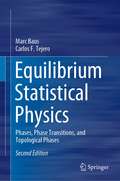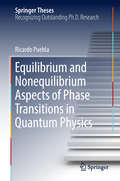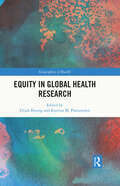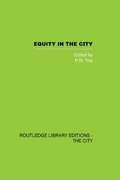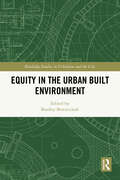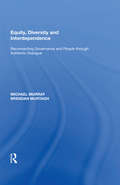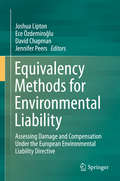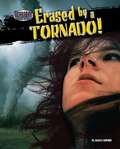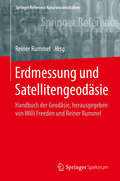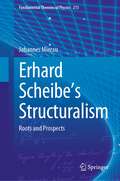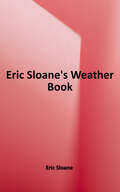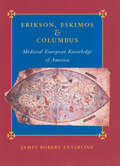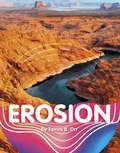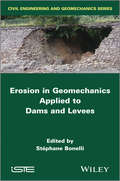- Table View
- List View
Equalizing the Three Pillars of Sustainability: Exploring Social Responsibility in Context (Approaches to Global Sustainability, Markets, and Governance)
by David Crowther Shahla SeifiThis book explores the multifaceted concept of sustainability, a term that has become central to global discussions among academics, policymakers, business leaders, and communities. Recognizing sustainability as a critical challenge for the future of our planet and its inhabitants, the book examines its three interconnected pillars: economic, environmental, and social. Among these, the social dimension is highlighted as having potentially the most profound impact on how we live and shape our collective future. Through a series of case studies and analyses, the book investigates actions taken across the globe to address sustainability, emphasizing the diversity of contexts, challenges, and outcomes. It goes beyond simply cataloging efforts, offering a deeper exploration of the conditions under which these initiatives were developed and implemented. The contributors, representing diverse international perspectives, provide valuable insights into local adaptations and global best practices, fostering a rich exchange of ideas and strategies. This book not only captures the current state of sustainability efforts but also reflects on emerging trends and the need for innovative approaches to navigate an ever-changing landscape. By bringing together global expertise, it aims to enrich the sustainability discourse and inspire meaningful progress. It is an essential read for those seeking a nuanced understanding of sustainability and its practical implications across economic systems, environmental stewardship, and societal transformation.
Equations and Analytical Tools in Mathematical Physics: A Concise Introduction
by Yichao ZhuThis book highlights a concise and readable introduction to typical treatments of partial differential equations in mathematical physics. Mathematical physics is regarded by many as a profound discipline. In conventional textbooks of mathematical physics, the known and the new pieces of knowledge often intertwine with each other. The book aims to ease readers' struggle by facilitating a smooth transition to new knowledge. To achieve so, the author designs knowledge maps before each chapter and provides comparative summaries in each chapter whenever appropriate. Through these unique ways, readers can clarify the underlying structures among different equations and extend one's vision to the big picture. The book also emphasizes applications of the knowledge by providing practical examples. The book is intended for all those interested in mathematical physics, enabling them to develop a solid command in using partial differential equations to solve physics and engineering problems in a not-so-painful learning experience.
Equations of Mathematical Physics
by A. A. Samarskii A. N. TikhonovMathematical physics plays an important role in the study of many physical processes -- hydrodynamics, elasticity, and electrodynamics, to name just a few. Because of the enormous range and variety of problems dealt with by mathematical physics, this thorough advanced undergraduate- or graduate-level text considers only those problems leading to partial differential equations. Contents:I. Classification of Partial Differential EquationsII. Evaluations of the Hyperbolic TypeIII. Equations of the Parabolic TypeIV. Equations of Elliptic TypeV. Wave Propagation in SpaceVI. Heat Conduction in SpaceVII. Equations of Elliptic Type (Continuation)The authors -- two well-known Russian mathematicians -- have focused on typical physical processes and the principal types of equations dealing with them. Special attention is paid throughout to mathematical formulation, rigorous solutions, and physical interpretation of the results obtained. Carefully chosen problems designed to promote technical skills are contained in each chapter, along with extremely useful appendixes that supply applications of solution methods described in the main text. At the end of the book, a helpful supplement discusses special functions, including spherical and cylindrical functions.
Equations of Motion in Relativistic Gravity (Fundamental Theories of Physics #179)
by Bernard Schutz Dirk Puetzfeld Claus LämmerzahlThe present volume aims to be a comprehensive survey on the derivation of the equations of motion, both in General Relativity as well as in alternative gravity theories. The topics covered range from the description of test bodies, to self-gravitating (heavy) bodies, to current and future observations.Emphasis is put on the coverage of various approximation methods (e.g., multipolar, post-Newtonian, self-force methods) which are extensively used in the context of the relativistic problem of motion. Applications discussed in this volume range from the motion of binary systems -- and the gravitational waves emitted by such systems -- to observations of the galactic center. In particular the impact of choices at a fundamental theoretical level on the interpretation of experiments is highlighted.This book provides a broad and up-do-date status report, which will not only be of value for the experts working in this field, but also may serve as a guideline for students with background in General Relativity who like to enter this field.
Equatorial Electrojet
by CAgodi OnwumechikliThis is the first book to review all the fields of equatorial electrojet phenomena and their relevant theories in one volume. In certain relevant sections, the book discusses both the equatorial electrojet and the world-wide parts of the Sq current systems. Onwumwchili is an internationally known and highly respected expert in the equatorial electrojet field- a brand of geomagnetism.
Equibalancedistribution (Eqbl) in der Analyse von Erdbebendaten: Einfluss des Risikos der Magnituden niederer Stärke auf spontane schwere Beben
by Marcus HellwigDas Buch beschreibt die Einschätzung des Risikos und der Wahrscheinlichkeit des Eintretens von Schäden gemäß Richterskala. Es erläutert die Verbindung der Wahrscheinlichkeitstheorie extremwertiger Prozesse mit Beispielen aus den Wissenschaften der Erdbebenbeobachtungen.
Equibalancedistribution (Eqbl) in the analysis of earthquake data: Influence of the risk of low magnitudes on spontaneous violent earthquakes
by Marcus HellwigThe book describes the assessment of the risk and probability of occurrence of damage according to the Richter scale. It explains the connection of the probability theory of extreme processes with examples from the sciences of earthquake observation. In contrast to many views, the present analysis takes into account the complete population of all measurement data of the magnitudes from 0 to the measured maximum
Equilibrium Compound Nucleus Post-Fission Theory
by Ye Tian Qing-Biao ShenThis book proposes and develops the equilibrium compound nucleus post-fission theory, a powerful tool for studying the fission process and making numerical calculations of post-fission nuclear data. It begins with a detailed historical background on fission theory and covers fundamental concepts, such as the Bohr-Wheeler formula and time dependent nuclear density functional theory.The authors explain the kinematics of heavy-ion collisions and develop a heavy-ion spherical optical model. They also present the theoretical methods for calculating the yield, kinetic energy distribution, and angular distribution of fission fragments in the initial state of fission. In addition, readers are provided with the method for calculating the prompt neutron and prompt gamma-ray data as well as the proportion of the isomeric state nucleus and independent yield from the initial yield of the fission fragments. Using the nuclear decay data of the fission products, a method for calculating the cumulative yield and decay heat of the fission fragments is also given. A fission delayed neutron simplification model is proposed and the theoretical method for calculating the total contribution of three fission channels to post-fission nuclear data is provided.This book concludes with a step-by-step guide on numerical calculations for post-fission nuclear data and a Fortran program for optimizing the best theoretical model parameters. It is ideal for both junior and senior researchers in nuclear physics, as well as graduate students who are interested learning about the subject. Given the current interest in post-fission and the tremendous experimental and theoretical efforts in studying it, this book serves as a timely and comprehensive resource for the nuclear physics community.
Equilibrium Statistical Physics: Phases, Phase Transitions, and Topological Phases
by Marc Baus Carlos F. TejeroThis is a textbook which gradually introduces the student to the statistical mechanical study of the different phases of matter and to the phase transitions between them. Throughout, only simple models of both ordinary and soft matter are used but these are studied in full detail. The subject is developed in a pedagogical manner, starting from the basics, going from the simple ideal systems to the interacting systems, and ending with the more modern topics. The textbook provides the student with a complete overview, intentionally at an introductory level, of the theory of phase transitions. All equations and deductions are included.
Equilibrium and Nonequilibrium Aspects of Phase Transitions in Quantum Physics (Springer Theses)
by Ricardo PueblaIn this book, the equilibrium and nonequilibrium properties of continuous phase transitions are studied in various systems, with a special emphasis on understanding how well-established universal traits at equilibrium may be extended into the dynamic realm, going beyond the paradigmatic Kibble–Zurek mechanism of defect formation. This book reports on the existence of a quantum phase transition in a system comprising just a single spin and a bosonic mode (the quantum Rabi model). Though critical phenomena are inherent to many-body physics, the author demonstrates that this small and ostensibly simple system allows us to explore the rich phenomenology of phase transitions, both in- and out-of-equilibrium. Moreover, the universal traits of this quantum phase transition may be realized in a single trapped-ion experiment, thus avoiding the need to scale up the number of constituents. In this system, the phase transition takes place in a suitable limit of system parameters rather than in the conventional thermodynamic limit – a novel notion that the author and his collaborators have dubbed the finite-component system phase transition. As such, the results gathered in this book will open promising new avenues in our understanding and exploration of quantum critical phenomena.
Equity in Global Health Research (Geographies of Health Series)
by Elijah Bisung Katrina M. PlamondonThis thoughtful book offers unique insights on global health research, drawing attention to the equity choices embedded in day-to-day patterns and assumptions that shape how people do, think about, and navigate research. It invites readers to position equity as the driving principle and purpose of this field and presents a plethora of examples that demonstrate how to navigate the complex work of centring equity in research. This book provides foundational content on the standards of guiding equity considerations in global health, with chapters adopting cross-disciplinary methods of engaging in equity thinking and doing. Chapters explore applications of six distinct elements of the CCGHR Principles for Global Health Research, including partnering authentically, embracing inclusion, sharing benefits, committing to the future, acting on causes of inequities and practicing humility. Each chapter is accompanied with engaging reflection questions. This book is a pivotal resource for those who perform, use or support global equity health research. It will appeal to students, researchers, policy makers, professionals and funders, as well as those with an interest in and commitment to centring equity in their approaches to doing, using, or supporting health research.
Equity in the City
by P. N. TroyEquity in the City is a collection of nine studies of the way the results of public investment in urban services are shared out among city-dwellers. The essays describe the way services such as water supply, electricity, roads and parks are financed and they analyse the way certain residents receive benefits from the public purse while others don't. It examines the impact on planning and zoning and building regulation in terms of who gains the benefits from government. Equity and the city reveals scarce public resources are allocated. This book was first published in 1981
Equity in the Urban Built Environment (Routledge Studies in Urbanism and the City)
by Bradley BereitschaftThis book explores inequities in the urban built environment across a diverse range of places and considers practical solutions and strategies aimed at building more just, inclusive, and sustainable cities.Achieving more equitable and prosperous urban places requires a critical examination of the design and layout of our cities. The 16 chapters of this book illuminate the ways in which the built environment, including buildings, roads, public spaces, and other infrastructure, shapes our health and prosperity through a complex set of physical and social interactions. It brings together experts from a variety of fields to identify, and suggest workable solutions for, inequities in the spatial distribution of amenities and disamenities and the processes and policies that give rise to these unjust patterns. Blending scholarly knowledge and practical experience, many of these strategies and solutions are presented through the lens of real-world case studies. One key takeaway is that the planning of our cities should be a communal effort that properly reflects the needs of all residents. Equity in the built environment can only be realized when people of diverse backgrounds, ethnicities, ages, and abilities feel welcome to both shape and enjoy the shared public realm.This book is intended for a wide audience that primarily includes scholars, students, and professionals in the fields of urban geography, urban planning, landscape architecture, and urban studies. Professionals in urban planning and policy with a desire to advance equity goals will likely appreciate the strategies, recommendations, and best practices discussed within.
Equity, Diversity and Interdependence: Reconnecting Governance and People through Authentic Dialogue (Perspectives On Rural Policy And Planning Ser.)
by Michael MurrayIf civil society is being encouraged to more fully embrace inclusiveness and respect for diversity, then so must the multiplicity of service support organizations with which it interacts. This is the key proposition behind this seminal contribution to public policy. While legislation can ensure minimum standards of behaviour and outcomes, meaningful organizational progression beyond legal imperatives requires authentic dialogue, based on principles of equity, diversity and interdependence. These are essential components for deeper societal transformation. Using the divided society of Northern Ireland as a case study, and its rural governance arena in particular, this book provides an authoritative empirical analysis of, and prescriptive agenda for, collaborative conversations. The insights provided by this book go far beyond this region and have a profound relevance for other societies struggling to emerge from conflict, racism and social separation.
Equivalency Methods for Environmental Liability
by Joshua Lipton Ece Özdemiroğlu David Chapman Jennifer PeersThe book is the only technical volume that explains how equivalency analysis methods mentioned in Annex II of the European Environmental Liability Directive should be implemented. It uses case studies to illustrate real-world application of the methods, which are based on the experience in the USA and in the European Union and have been tested in three years of training programs funded by the European Commission. Academically rigorous and technically comprehensive, the book is intended for technical experts wanting to assess damage and remediation options as well as for decision-makers wishing to commission such assessments and judge their quality. These include competent authorities, operators, financial security providers, academics, consultants and NGOs.
Erased by a Tornado! (Disaster Survivors)
by Jessica RudolphOn February 5, 2008, a powerful tornado ripped through Jackson, Tennessee, leveling everything in its path. Dangerous and unpredictable, tornadoes are monster storms that can strike without warning. With little time to find shelter, how would residents of Jackson survive the storm? Eyewitness accounts and incredible photos bring to life the experiences of ordinary people who faced catastrophic danger -and lived to tell their stories. Kids will discover the causes and characteristics of tornadoes and learn about scientific advances in storm prediction. Safety tips show young readers what to do in case a tornado hits.
Erdmessung und Satellitengeodäsie
by Reiner RummelDas Handbuch der Geodäsie ist ein hochwertiges, wissenschaftlich fundiertes Werk über die Geodäsie unserer Zeit und bietet anhand von in sechs Bänden zusammengestellten Einzelthemen ein repräsentatives Gesamtbild des Fachgebiets. Satelliten führten zu einer Revolution in der Geodäsie. Erst mit Hilfe von Satelliten wurde die Erdmessung tatsächlich global und dreidimensional. Ozeane und Eisschilde stellen keine Hindernisse mehr dar, sie lassen sich heute mit gleicher Präzision vermessen wie die Kontinente. Verfeinerungen resultieren aus der Kombination von Raumverfahren mit terrestrischen Messmethoden. Damit gelingt es der Erdmessung, fundamentale Beiträge zum Verständnis des Erdsystems und des Klimawandels zu liefern. Voraussetzung für diese Entwicklung sind sehr moderne Messverfahren und Auswertemethoden und deren extrem genaue Verknüpfung in einem globalen erd- und raumfesten Referenzsystem. Im Band Erdmessung und Satellitengeodäsie werden exemplarisch die historischen Wurzeln, methodischen Grundlagen, verwendeten Messverfahren sowie die Forschungstrends vorgestellt.
Erdélyi–Kober Fractional Calculus: From a Statistical Perspective, Inspired by Solar Neutrino Physics (SpringerBriefs in Mathematical Physics #31)
by A. M. Mathai H. J. HauboldThis book focuses on Erdélyi–Kober fractional calculus from a statistical perspective inspired by solar neutrino physics. Results of diffusion entropy analysis and standard deviation analysis of data from the Super-Kamiokande solar neutrino experiment lead to the development of anomalous diffusion and reaction in terms of fractional calculus. The new statistical perspective of Erdélyi–Kober fractional operators outlined in this book will have fundamental applications in the theory of anomalous reaction and diffusion processes dealt with in physics.A major mathematical objective of this book is specifically to examine a new definition for fractional integrals in terms of the distributions of products and ratios of statistically independently distributed positive scalar random variables or in terms of Mellin convolutions of products and ratios in the case of real scalar variables. The idea will be generalized to cover multivariable cases as well as matrix variable cases. In the matrix variable case, M-convolutions of products and ratios will be used to extend the ideas. We then give a definition for the case of real-valued scalar functions of several matrices.
Erhard Scheibe's Structuralism: Roots and Prospects (Fundamental Theories of Physics #213)
by Johannes MierauThis book offers the first systematic review of the structuralism of physical theories. Particular emphasis is placed on the inclusion of empirical imprecision into formal reconstructions of theories. The proposed measure of imprecision allows for a topological comparison of theories. Considering the ongoing debates on the nature of the thermodynamic limit in statistical mechanics, as well as on limit relations between classical and quantum mechanics, the author asserts that the Bourbaki-style structuralism, together with E. Scheibe's theory of reduction, is the best choice for reconstructing and analyzing the related questions of reduction and emergence. Readers will appreciate the critical overview of the main positions in philosophy of science, examined with particular attention to their applicability to current problems of fundamental theories of physics.
Eric Sloane's Weather Book
by Eric SloaneThe author instructs readers how to glean climate information by "reading" such natural phenomena as winds, skies, and animal sounds. A beautifully illustrated and practical treasure trove of enlightening lore for outdoorsmen, farmers, sailors, and anyone who has ever wondered whether to take an umbrella when leaving the house.
Erikson, Eskimos & Columbus: Medieval European Knowledge of America
by James Robert EnterlineThis revealing analysis of Medieval cartography and native American travel upends conventional narratives about discovering the New World.For generations, American schools have taught children that Christopher Columbus discovered America in 1492. But evidence shows that Leif Erikson set foot on the continent centuries earlier. As debate continues over which explorer deserves the credit, early maps of North America suggest that we may be asking the wrong questions. How did medieval Europeans have such specific geographic knowledge of North America, a land even their most daring adventurers had not yet discovered? In Erikson, Eskimos, and Columbus, James Robert Enterline presents new evidence that traces this knowledge to the cartographic skills of indigenous people of the high Arctic, who, he contends, provided the basis for medieval maps of large parts of North America. Drawing on an exhaustive chronological survey of pre-Columbian maps, including the controversial Yale Vinland Map, this book boldly challenges conventional accounts of Europe’s discovery of the New World.
Erikson, Eskimos, and Columbus: Medieval European Knowledge of America
by James Robert EnterlineHow did medieval Europeans have such specific geographic knowledge of North America, a land even their most daring adventurers had not yet discovered? In Erikson, Eskimos, and Columbus, James Robert Enterline presents new evidence that traces this knowledge to the cartographic skills of indigenous people of the high Arctic, who, he contends, provided the basis for medieval maps of large parts of North America. Drawing on an exhaustive chronological survey of pre-Columbian maps, including the controversial Yale Vinland Map, this book boldly challenges conventional accounts of Europe's discovery of the New World.
Erosion (Earth Materials and Systems)
by Tamra B. OrrErosion changes Earth's natural features. It breaks down materials and can help make something new. Discover why erosion is an important part of nature!
Erosion and Sedimentation
by Pierre Y. JulienThe second edition of this acclaimed, accessible textbook brings the subject of sedimentation and erosion completely up-to-date, providing an excellent primer on both fundamental concepts of sediment-transport theory and methods for practical applications. The structure of the first edition is essentially unchanged, but all the chapters have been updated, with several chapters reworked and expanded significantly. Examples of the new additions include the concept of added mass, the Modified Einstein Procedure, sediment transport by size fractions, sediment transport of sediment mixtures, and new solutions to the Einstein Integrals. Many new examples and exercises have been added. Erosion and Sedimentation is an essential textbook on the topic for students in civil and environmental engineering and the geosciences, and also as a handbook for researchers and professionals in engineering, the geosciences and the water sciences.
Erosion in Geomechanics Applied to Dams and Levees
by Stéphane BonelliErosion is the most common cause of failures at earth-dams, dikes and levees, whether through overtopping and overflowing, or internal erosion and piping. This book is dedicated to the phenomenon of internal erosion and piping. It is not intended to be exhaustive on the subject, but brings together some of the latest international research and advances. Emphasis is placed on physical processes, how they can be studied in the laboratory, and how test results can be applied to levees and dams. The results from several research projects in Australia, France, the Netherlands and the United States are covered by the authors. Our aim has been to share our most recent findings with students, researchers and practitioners. Understanding the failure of an earth-dam or a levee by erosion in a unified framework, whether internal erosion or surface erosion, requires continuous research in this field. We hope that the reader will gain knowledge from this book that leads to further progress in the challenging field of the safety of levees and dams. Contents 1. State of The Art on the Likelihood of Internal Erosion of Dams and Levees by Means of Testing, Robin Fell and Jean-Jacques Fry. 2. Contact Erosion, Pierre Philippe, Rémi Beguin and Yves-Henri Faure. 3. Backward Erosion Piping, Vera Van Beek, Adam Bezuijen and Hans Sellmeijer. 4. Concentrated Leak Erosion, Stéphane Bonelli, Robin Fell and Nadia Benahmed. 5. Relationship between the Erosion Properties of Soils and Other Parameters, Robin Fell, Gregory Hanson, Gontran Herrier, Didier Marot and Tony Wahl. About the Authors Stéphane Bonelli is a Research Professor at Irstea (French Environmental Sciences and Technologies Research Institute) in Aix-en-Provence, France. He has over 20 years of teaching and research experience, and has been a member of the ICOLD (International Commission on Large Dams) European Working Group on Internal Erosion since 2005. He has participated in 19 large dam reviews in France (visual inspection, monitoring data analysis and numerical modeling). His current activities include research, teaching and consultancy, focusing on soil erosion and the processes of levee breach.
